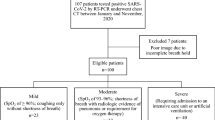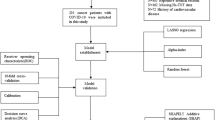Abstract
Background
Haemoperfusion (HP) is an innovative extracorporeal therapy that utilizes special cartridges to filter the blood, effectively removing pro-inflammatory cytokines, toxins, and pathogens in COVID-19 patients. This retrospective cohort study aimed to assess the clinical benefits of HP for severe COVID-19 cases using Shapley values for machine learning models.
Methods
The research involved 578 inpatients (≥ 20 years old) admitted to Baqiyatallah hospital (Tehran, Iran). The control group (359 patients) received standard treatment, including high doses of corticosteroids (a single 500 mg methylprednisolone pulse, followed by 250 mg for 2 days), categorized as regimen (I). On the other hand, the HP group (219 patients) received regimen II, consisting of the same corticosteroid treatment (regimen I) along with haemoperfusion using Cytosorb H300. The frequency of haemoperfusion sessions varied based on the type of lung involvement determined by chest CT scans. In addition, the value function \({\text{v}}\) defines the Shapley value of the \(i\)th feature for the query point \({\text{x}}\), where the input matrix features represent individual characteristics, drugs, and history and clinical conditions of the patient.
Results
Our data showed a favorable clinical response in the HP group compared to the control group. Notably, one-to-three sessions of HP using the CytoSorb® 300 cartridge led to reduced ventilation requirements and mortality rates in severe COVID-19 patients. Shapley values were calculated to evaluate the contribution of haemoperfusion among other factors, such as side effects, medications, and individual characteristics, to COVID-19 patient outcomes. In addition, there is a significant difference between the two groups among the treatments and medications used remdesivir, adalimumab, tocilizumab, favipiravir, Interferon beta-1a, enoxaparin prophylaxis, enoxaparin full dose, heparin prophylaxis, and heparin full dose (P < 0.05).
It seems that haemoperfusion has a positive impact on the reduction of inflammation markers and renal functional such as ferritin and creatinine, respectively, as well as d-dimer and WBC levels in the HP group were significantly lower than the control group.
Conclusion
The findings indicated that haemoperfusion played a crucial role in predicting patient survival, making it a significant feature in classifying patients' prognoses.



Similar content being viewed by others
Availability of data and materials
The datasets used and/or analyzed during the current study are available from the corresponding authors on reasonable request.
References
Abbasi S, Naderi Z, Amra B, Atapour A, Dadkhahi SA, Eslami MJ, Hajian MR, Hashemi M, Hashemi ST, Iraj B, Khorvash F, Madadi S, Pour HM, Mansourian M, Rezvani M, Sami R, Soltaninejad F, Shahidi S, Vahdat S, Zamani Z, Moeinzadeh F (2021) Haemoperfusion in patients with severe COVID-19 respiratory failure, lifesaving or not? J Res Med Sci 27(26):34. https://doi.org/10.4103/jrms.JRMS_1122_20. (PMID:34345245; PMCID:PMC8305775)
Abedian M, Hejazi M (2023) Optimal strategy selection under fuzzy environment for strategic planning methodology selection: an SWOT approach. Cybern Syst. https://doi.org/10.1080/01969722.2023.2166255
Balas RB, Meliț LE, Mărginean CO (2023) COVID-19 and cardiac implications: still a mystery in clinical practice. Rev Cardiovasc Med 24(5):125
Bui TN, Ngo HA, Huynh NM, Do-Tran NH, Le LD, Nguyen TA (2022) High-dose methylprednisolone pulse therapy for the treatment of patients with severe COVID-19: results from a prospective observational study. J Intensive Med 2(03):197–198
Cao X (2020) COVID-19: immunopathology and its implications for therapy. Nat Rev Immunol 20(5):269–270
Cegolon L, Einollahi B, Panahi Y, Imanizadeh S, Rezapour M, Javanbakht M, Mastrangelo G (2022b) On therapeutic plasma exchange against severe COVID-19-associated pneumonia: an observational clinical study. Front Nutr 9:809823
Cegolon L, Einollahi B, Panahi Y, Imanizadeh S, Rezapour M, Javanbakht M, Mastrangelo G (2022) On the efficacy of therapeutic plasma exchange against severe COVID-19 pneumonia: a clinical observational study. J Clin Immunol
Chen S et al (2023) Advances in attractive therapeutic approach for macrophage activation syndrome in COVID-19. Front Immunol. https://doi.org/10.3389/fimmu.2023.1200289
Cutuli SL et al (2023) Antimicrobial exposure in critically ill patients with sepsis-associated multi-organ dysfunction requiring extracorporeal organ support: a narrative review. Microorganisms 11(2):473
Dastan F, Saffaei A, Mortazavi SM, Jamaati H, Adnani N, Samiee Roudi S, Hashemian SM (2020) Continues renal replacement therapy (CRRT) with disposable haemoperfusion cartridge: a promising option for severe COVID-19. J Glob Antimicrob Resist 21:340–341
Elwan TH et al (2023) Unveiling the role of inflammatory mediators and gut microbiome in appendicitis: types and applications in clinical scoring. Adv Gut Microbiome Res 2023:1–12
Esmaeili Vardanjani A, Ronco C, Rafiei H, Golitaleb M, Pishvaei MH, Mohammadi M (2021) Early haemoperfusion for cytokine removal may contribute to prevention of intubation in patients infected with COVID-19. Blood Purif 50(2):257–260
Ghaleh HEG, Izadi M, Javanbakht M, Ghanei M, Einollahi B, Jafari NJ, Alvanagh AG (2023) Cytokine profile and antioxidants status in the moderate and severe COVID-19 patients: a trial of ozone therapy impact as a medicinal supplement. Inflammopharmacology 31(6):3029–3036
Han H, Ma Q, Li C, Liu R, Zhao L, Wang W, Xia Y (2020) Profiling serum cytokines in COVID-19 patients reveals IL-6 and IL-10 are disease severity predictors. Emerg Microbes Infect 9(1):1123–1130
Hsu CY, Rheima AM, Kadhim MM, Ahmed NN, Mohammed SH, Abbas FH, Kianfar E (2023) An overview of nanoparticles in drug delivery: properties and applications. South Afr J Chem Eng 46:233–270
Huang C, Wang Y, Li X, Ren L, Zhao J, Hu Y, Cao B (2020) Clinical features of patients infected with 2019 novel coronavirus in Wuhan, China. The Lancet 395(10223):497–506
Jacques-Aviñó C et al (2020) Gender-based approach on the social impact and mental health in Spain during COVID-19 lockdown: a cross-sectional study. BMJ Open 10(11):e044617
Ju H et al (2023) Recent trends in anti-cancer activities of terrestrial plants-based polysaccharides: a review. Carbohydr Polym Technol Appl 6:100341
Kianfar E (2021a) Magnetic nanoparticles in targeted drug delivery: a review. J Supercond Novel Magn 34(7):1709–1735
Kianfar E (2021b) Protein nanoparticles in drug delivery: animal protein, plant proteins and protein cages, albumin nanoparticles. J Nanobiotechnol 19(1):159
Li M et al (2023) An order-invariant and interpretable dilated convolution neural network for chemical process fault detection and diagnosis. IEEE Trans Autom Sci Eng. https://doi.org/10.1109/TASE.2023.3290202
Long X et al (2023) Identifying the evolution of primary oxidation mechanisms and pollutant degradation routes in the electro-cocatalytic Fenton-like systems. J Hazard Mater 445:130577
Lundberg SM, Lee S-I (2017) A unified approach to interpreting model predictions. Advances in neural information processing systems
Maity S et al (2023) Targeting cytokine storm as the potential anti-viral therapy: Implications in regulating SARS-CoV-2 pathogenicity. Gene 881:147612
Majeed AY, Zulkafli NES, Ad’hiah AH (2023) Serum profiles of pro-inflammatory and anti-inflammatory cytokines in non-hospitalized patients with mild/moderate COVID-19 infection. Immunol Lett 260:24–34
McElvaney OJ, McEvoy NL, McElvaney OF, Carroll TP, Murphy MP, Dunlea DM, McElvaney NG (2020) Characterization of the inflammatory response to severe COVID-19 illness. Am J Respir Crit Care Med 202(6):812–821
Molaei H, Shojaeefar E, Nemati E, Khedmat L, Mojtahedi SY, Jonaidi Jafari N, Einollahi B (2022) Iranian patients co-infected with COVID-19 and mucormycosis: the most common predisposing factor, clinical outcomes, laboratory markers and diagnosis, and drug therapies. Infect Dis 54(8):600–613
Morsy MI et al (2021) A novel LC-MS/MS method for determination of the potential antiviral candidate favipiravir for the emergency treatment of SARS-CoV-2 virus in human plasma: Application to a bioequivalence study in Egyptian human volunteers. J Pharm Biomed Anal 199:114057
Nayebi A et al (2023) WindowSHAP: an efficient framework for explaining time-series classifiers based on Shapley values. J Biomed Inform 144:104438
Ni R et al (2023) Biologic mechanisms of macrophage phenotypes responding to infection and the novel therapies to moderate inflammation. Int J Mol Sci 24(9):8358
Olsen LHB et al (2023), A comparative study of methods for estimating conditional Shapley values and when to use them. arXiv preprint arXiv:2305.09536
Onuk S et al (2023) Cytokine levels and severity of illness scoring systems to predict mortality in COVID-19 infection. Healthcare 11(3):387
Pan F et al (2020a) Time course of lung changes at chest CT during recovery from coronavirus disease 2019 (COVID-19). Radiology 295(3):715–721
Pan F, Ye T, Sun P, Gui S, Liang B, Li L, Zheng C (2020b) Time course of lung changes at chest CT during recovery from coronavirus disease 2019 (COVID-19). Radiology 295(3):715–721
Panahi Y, Einollahi B, Beiraghdar F, Darvishi M, Fathi S, Javanbakht M, Akhavan-Sigari R (2022) Fully understanding the efficacy profile of the COVID-19 vaccination and its associated factors in multiple real-world settings. Front Immunol 13:947602
Pham K et al (2023) Machine learning-based pedotransfer functions to predict soil water characteristics curves. Transp Geotech 42:101052
Reddy S et al (2023) Predicting swarm equatorial plasma bubbles via machine learning and Shapley values. J Geophys Res: Space Phys. https://doi.org/10.1029/2022JA031183
Ronco C, Bellomo R (2022) Haemoperfusion: technical aspects and state of the art. Crit Care 26(1):1–12
Rostami Z, Futuhi F, Nemati E, Najafabadi AS, Javanbakht M, Ebrahimi M, Einollahi B (2022a) Dialysis during the COVID-19 pandemic: experiences from 4 dialysis centers in Iran. Nephro-Urol Mon. https://doi.org/10.5812/numonthly-127290
Rostami Z, Mastrangelo G, Einollahi B, Nemati E, Shafiee S, Ebrahimi M, Cegolon L (2022b) A prospective study on risk factors for acute kidney injury and all-cause mortality in hospitalized COVID-19 patients from Tehran (Iran). Front Immunol 13:874426
Sayyadi M et al (2023) Status of major hemostatic components in the setting of COVID-19: the effect on endothelium, platelets, coagulation factors, fibrinolytic system, and complement. Ann Hematol 102(6):1307–1322
Selvaraj V et al (2021) Tocilizumab in hospitalized patients with COVID-19: a meta analysis of randomized controlled trials. Lung 199(3):239–248
Smith M, Alvarez F (2021) Identifying mortality factors from Machine Learning using Shapley values - a case of COVID19. Expert Syst Appl 176:114832. https://doi.org/10.1016/j.eswa.2021.114832. (PMID: 33723478; PMCID: PMC7948528)
Soleimani A, Taba SMM, Hasibi Taheri S, Loghman AH, Shayestehpour M (2021a) The effect of haemoperfusion on the outcome, clinical and laboratory findings of patients with severe COVID-19: a retrospective study. New Microbes New Infect 44:100937. https://doi.org/10.1016/j.nmni.2021.100937. (PMID: 34490065; PMCID: PMC8410636)
Tim Y et al (2023) Design process knowledge for crisis-driven information systems solutions: Insights on building digital resilience from an action design research study. Inf Syst J. https://doi.org/10.1111/isj.12457
Tlemsani I, Matthews R, Mohamed Hashim MA (2023) Revisiting Zakat with a distribution of weighted Shapley value. Int J Islam Middle East Financ Manag 16(6):1141–1158
Winchester JF (2002) Dialysis and haemoperfusion in poisoning. Adv Ren Replace Ther 9(1):26–30
Zhang C, Wu Z, Li JW, Zhao H, Wang GQ (2020) Cytokine release syndrome in severe COVID-19: interleukin-6 receptor antagonist tocilizumab may be the key to reduce mortality. Int J Antimicrob Agents 55(5):105954
Zhang G, Su L, Wu W, Qiao Q, Gao S, Zhang Y, Zhang Y (2024) Efficacy of different doses of corticosteroids in treating severe COVID-19 pneumonia. Virol J 21(1):74
Zhu B et al (2021) Correlation between white blood cell count at admission and mortality in COVID-19 patients: a retrospective study. BMC Infect Dis 21:1–5
Acknowledgements
Thanks to guidance and advice from “Clinical Research Development Unit of Baqiyatallah Hospital".
Funding
Not applicable.
Author information
Authors and Affiliations
Contributions
All authors’ participated design the study, performed the experiments, analyzed the results, and wrote the manuscript. All authors read and approved the final manuscript.
Corresponding authors
Ethics declarations
Conflict of interest
The authors declare that they have no conflict of interest.
Ethical approval and consent to participate
This study was conducted according to the guidelines laid down in the Declaration of Helsinki, and all procedures involving research study participants were outlined in the study protocols approved by the Baqiyatallah Universities of Medical Science. This trial was also approved by the Independent Ethics Committees of University (The trial number, IR.BMSU.IRCT.1399.447). Written informed consent was obtained from all the participants.
Consent to publication
Not applicable.
Additional information
Publisher's Note
Springer Nature remains neutral with regard to jurisdictional claims in published maps and institutional affiliations.
Rights and permissions
Springer Nature or its licensor (e.g. a society or other partner) holds exclusive rights to this article under a publishing agreement with the author(s) or other rightsholder(s); author self-archiving of the accepted manuscript version of this article is solely governed by the terms of such publishing agreement and applicable law.
About this article
Cite this article
Einollahi, B., Javanbakht, M., Ebrahimi, M. et al. Surveying haemoperfusion impact on COVID-19 from machine learning using Shapley values. Inflammopharmacol (2024). https://doi.org/10.1007/s10787-024-01494-z
Received:
Accepted:
Published:
DOI: https://doi.org/10.1007/s10787-024-01494-z




